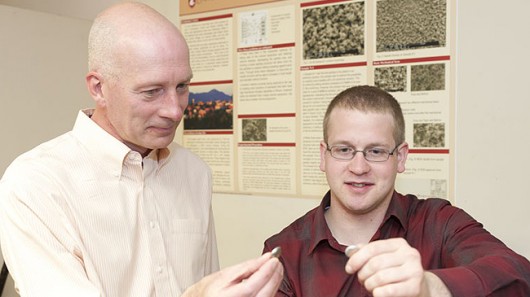"Tin whiskers" could triple the capacity of lithium-ion batteries
By Ben Coxworth
15:09 June 11, 2012

Tin anode creator Prof. Grant Norton and student, David Mackay
For over 60 years, electrical engineers have been trying to minimize the problem of tin whiskers. Growing on tin-plated electronics, the needle-like structures get up to ten millimeters long, and can cause short circuits. Instead of trying to eliminate them, however, Washington State University’s Prof. Grant Norton has been looking into ways of growing them – albeit in a controlled manner. His research has led to the creation of a tin battery anode, which he claims could triple the capacity of lithium-ion batteries.
Ordinarily, the anodes in lithium-ion batteries are made from graphite. When the battery is being charged, lithium ions move onto the anode from the cathode – the larger the amount of ions that can be held on the anode, the more energy the battery can store. Once the battery is in use, the ions create an electric circuit as they move back to the cathode, discharging electrons in the process.
Norton and postdoctoral researcher Uttara Sahaym were originally trying to mitigate tin whiskers, when they realized that they could actually be useful. The nanoneedles (or “whiskers”) subsequently used for the tin anode were grown directly on copper foil, using a standard electroplating process. This reportedly means that the tin anode would be considerably cheaper to produce than traditional graphite anodes.
The "tin whiskers" used for the anode
More importantly, however, lab tests have also shown that the tin anode offers almost triple the energy storage capacity as its graphite counterparts – this comes thanks to the plentiful surface area of the whiskers, which provides a roost for a larger number of lithium ions. Additionally, batteries incorporating the tin anode could recharge more quickly and many more times than existing li-ions.
Norton and his colleagues are now in the process of building and testing batteries using their new anode. They have filed patents on the technology, and hope to have it commercialized within a year. Batteries incorporating the tin anode should be no different in shape or size than traditional batteries, so compatibility with devices shouldn’t be a problem.
Source: Washington State University via Forbes
Copyright © gizmag 2003 - 2012 To subscribe or visit go to: http://www.gizmag.com
